My first trip on the Rajdhani. Besides occasional disturbances from the Hathi’s side, the trip was more or less enjoyable. Most of the pleasure being derived from sending a hapless steward back and forth to fetch innumerable sachets of sugar and ketchup. On realizing that the two of us had no intention of shifting our arses, so to say, from the comfortably elevated position that even Hathi couldn’t drag us away from, the latter settled down to obediently rip DVDs, as we had commanded him, and to entertain a group of very inquisitive children. As we approached Delhi, the view from the window came to be increasingly dominated by sugarcane and mustard fields. Something my Malayali self found extremely novel. But then, everything about this trip was novel.
And then, Delhi Central. There is something about huge metropolitan Railway Stations. A river of humanity. So much noise. And yet, I don’t believe I am wrong when I say it is the most profound silence that civilization offers. Each man an island, a person is the most objective observer of life at this busy junction. I have read somewhere that the human eye is the most wondrous of all creations, a revolving door, where the creative spirit meets the created spirit. I would extend the comparison to all my senses. It allows the universal conscious to perceive the magnitude of its ingenuity. There is the guy in the dhoti spitting pan, the wailing babes, moms yelling, porters in red uniforms, hungry Hathi….Then there is this thing about Indian porters- they basically wait at the doors of the train, grab your luggage and refuse to return it until you agree to hire them. Really! I never cease to be amazed at the will of the living organism to survive.
The rest of Delhi Station is a blur. Perhaps due to the fact that I spent a lot of time trying to keep track of Hathi’s Samsonite bag through the large mist of humanity that kept swarming around him. He refuses to acknowledge that I am five feet tall and have naturally short legs. After making sure that he was suitably fed and settled in a quiet corner of the station where he could do no harm, we left for Rohtak.
Great Roads. The first thing that came to mind. Once you were on the outskirts of Delhi, making your way into Haryana, the roads were, as the locals put it, like "Makhan, malai", incredibly smooth and wide. Sugarcane, wheat, mustard, painted the landscape, dusty green, flaky brown and vibrant yellow. Quaint villages lined the roadside. An old man with a signature mustache, snow-white and curling upwards in majesty, blows into his hookah. The women, strong and ruddy, betray their ancestry. Tanima explains to me that the Haryanvis are descendents of the union of Pathans with the indigenous races. Their culture, physical appearance and dialect reflect this joint heritage. The women wore the dupattas of their salwar suits so intricately wrapped around their head and shoulders that only the slit of their eyes was visible. A purdah system, subtle, but effective nevertheless. And yet they were not averse to hard physical labour. There is even a joke round these parts that when they first decided to separate Haryana and Punjab, the policy makers declared that wherever the women started working in the fields, that would demarcate where Haryana begins, and as a natural consequence, where Punjab ends. Since most men here join the Army, it is up to the women to tend the fields and look after the family. I wonder whether this was the legendary land of the Amazons that the Greek poets refer to. I can literally see these women, clad in tiger skin, with eagles on their breastplate, screaming for war. But then my imagination runs away with me.
Another interesting feature I had the chance to note was that there were lots of temples dedicated to the Lord Hanuman in this state. He is apparently the patron God of warriors. The beautiful thing about our country is, the way people can worship freely, the form of God they identify with most. In fact, the majority religion in our country, Hinduism, is a kaleidoscopic celebration of secular thought in itself. Marwadis in my hostel set up little shrines for the Goddess Lakshmi, Bengalis erect intricate pandals to Durga Ma, artists sing praises to Saraswati, Tanima gave me a picture of Ganeshji to take with me when I gave my GRE and young women all over India keep a portrait of the young Lord Krishna eating curd. I believe this lies at the core of our tolerance of other peoples and cultures and our assimilation of them. And also at the core of a profound spirituality that permeates the fabric of our everyday existence. The Indian God is above all a personal God, never a compulsion, always a choice.
At Tanima’s place, her Father received us, a very jovial person, who has generously donated a healthy portion of good humour to his forever grinning offspring. I had finally established the source of Fatass’ funny bone. Lunch was brilliant. Tanima’s Mom had made Chola Bhatura, expressly at her request. Ever since, I have been quite incapable of eating the miserable substitute offered by the H-9 mess. Later on in the course of the day, the two younger siblings appeared, so to say. As we poured over BIT memorabilia and related the oft repeated tales and sagas to Pankhuri aka Gullu (Fatass’ Faery-like younger sister), Pranjal (the genius of a brother) plays incessantly with the baby doll we gifted Dubeyji on her birthday. Among other things, the doll could say "mama", "papa" and sing "tuki tuki tup tup." Pranjal couldn’t get enough of the singing and I guess Uncle had more than his share. He stares at Pranjal and tells him to stop playing. Why? Because if the battery is exhausted, we won’t get spares anywhere round here. Peals of laughter. It’s been ages since we’ve heard situational sarcasm delivered with such flair.
Aunty was back from the University around five. Most of you must have heard of Lord Byron’s "She Walks in Beauty." Aunty could have been the woman Byron was talking about. There are just two other contemporary women who could have been his subjects, my Mother or my Grandmother. But then, yes, Byron wrote it a hundred years ago, I know, I know. For the sake of comparison, people!!! Five feet tall, swathed in a deep purple silk sari, she still looked like she was in her twenties, very sprightly with twinkling eyes and dimpled cheeks. She loved to drink tea like most people of the old school and she had a happy way of bringing her hands together whenever she spoke. She was truly a very beautiful woman.
In the evening, we went out for a bit. Having discovered the Banta, a lime soda drink shot through with kala namak (half the pleasure lies in seeing….and hearing the man making the thing. Pop! Squuesh! Pfzzzz!) , I went on to spend nearly 2000 Rupees on a very flashy pink suit piece for my sister, totally smothered in embroidery and sequins. Dubey informed me that it was typical Punjabi shaadi wear. After rigorous calculations, I figured 2000 was definitely a decent price to pay for the humiliation of a younger sibling who had no shaadi to attend and would therefore be forced, by my very patriotic parents, to don the habit at one of my mother’s innumerable kitty parties.
Oh yes! Let me tell you before it slips out of my mind - if you ever go to Haryana, I must tell you, the kulfis are to die for. Solidified milk cream seasoned with elaichi, badam and I can’t say what else.
Next stop, a typical Haryanvi house.
Haryanvi houses generally have very interesting motifs carved into the walls. The house I had been to had birds, particularly storks, as a predominant theme. The walls are generally done in pastel shades and the motifs tinted a pale blue or deep navy. The furniture is generally very functional. The hookah is a necessary part of the décor and an intellectual meeting point for the men in the house. Since the fire had nearly died out, Uncle allowed the two of us girls to take a puff. For five minutes, we listened to ourselves make gurgling noises….and then we grew up. They had a large silo to store the wheat. I have never seen a silo before and for those of you who haven’t, allow me to describe it for you. It is a large cylindrical tin can, with a lid to pour the wheat flour in, and a small kitty-trap kind of door in front, to retrieve it later. Very funky.
Somewhere in between this potpourri of events, Pranjal and Gullu discovered that I had never seen a live buffalo before and this started what could be called a rather relentless period of buffalo spotting where the two of them pointed at a number of assorted buffaloes that they encountered, for my benefit.
Unfortunately, the incorrigible trio also discovered that I have never seen Sholay before, which in India, amounts to treason. To remedy this sorry state of affairs, a VCD was hastily purchased and I was instructed to watch this monumental Bollywood saga. I struggled to keep myself awake but my tired eyes refused to take in anything after Basanti elopes with Dharmendra’s character or at least what seems like it. I think his name was Kalia. Whatever. End of Day one.
The next day I spent lazing around, while I arrogantly proclaimed to the world that I was writing my SOPs. Observation: I never knew that roti could be made of corn flour. But yes, I am introduced to Makki di roti and sarson da sag. I hope I got it right this time. Sometime in the evening we decide to surprise everyone by preparing Litti.
I am interrupted by two big surprises of my own. Tilak Bhaiyya, the very cute driver, and Tanima’s Dad unanimously think that it’s a shame I’ve never had sugar cane before. Two separate loads of sugarcane have been arranged, again for my benefit, Tilak Bhaiyya, having gone the extra mile, stealing it from a factory for me. Unfortunately my teeth are not the material Vicco Vajradanthi advertisements are made of and two inches of the cane can uproot most of them. Uncle threatens that if I don’t finish it, I will have to take the rest of them with me to Saudi. I nervously chop onions for the Litti. We end up making something that is definitely not Litti but tastes fantabulous never the same. End of Day two.
Uncle has to leave to Hyderabad for a conference. After we drop him off at the Air Port, we head for the Air India office at Connought Place to confirm my international ticket.
During my 21 years of being an NRI and nearly 15 years of being a fully conscious NRI, Air India has taken an incredible amount of trouble to establish that they are the worst means of International aviation available. And yet again, they dramatically exceed my expectations. They achieve amazing new levels of incompetence and inconvenience. Besides ordering me to translate my Visa which was already in English to English, they treat Tanima’s Mother with not even a pretense at basic courtesy. Also, the guy at the counter was suspiciously aware of the number of the stall at Sarojini market where I could get it done. And the cost (300 bucks). Infuriated at this turn of events, we approached one of his superiors who informed us that the translation was required because Saudis look at the moon and we follow the sun. The next half an hour the two of us spent in giving a lecture on reading English and assimilating it. Seeing that I was not the average dumb teenager traveling alone, AI finally had to give up. Ta da! (symbols clanging, angels singing, trumpets in the sky)
What followed was a whirlwind tour of the underground market, Janpath and numerous other markets where we purchased a range of junk jewellery, bags and trinkets at bargain prizes. The problem with bargains is that you end up buying much more than you intend to and then later, you are forced to buy clothes at not-such-a-bargain prices to go with the accessories.
I have formally declared myself madly in love with the Delhi Metro. It looks like a slice of Australia in India, great staff, great rates, great look, great services- forcing Indians to treat their public transport with respect. No paan spitting or littering here, this is truly a holy place. Kudos to Mr. Sashidharan and his team for completing it in time and to the Indian junta for keeping it spanking clean.
On the way back to Rohtak, we get stuck in a three hour long traffic jam. Punjabi shaadi. Hmmm. End of day three.
National Bandh. Damn! What do we do now? Gullu, I and Pranjal settle down to make Cheenu didi’s favourite snack- blueberry muffins. Gullu exerts all her mental and physical prowess to get the can of blueberries to open. I keep my hands in the dough and swirl it around coz I am sure opening the tin is beyond my intellect, or my strength. The dough is cold and after five minutes I cannot feel my fingers. Hardly are the muffins in the oven, Tanima ushers us out to see an Indus Valley Civilization excavation site.
We spend two hours in the Honda Civic, getting to a remote village, on the outskirts of the technically defined outskirts of Rohtak. Two young men in pronounced neon jackets-one yellow, the other orange-take us to a small house, by the side of which runs a wall with cow dung cakes plastered all over. This semi-plateau like structure juts over a vast planar area where rows and rows of dung cakes have been neatly arranged. Where the vertical surface of the plateau met the surface below was a trench, one foot wide and maybe two feet deep. Our guide explained to us that certain statues and artifacts had been found in that trench. "What kind of artifacts?" He had no idea. "Which period?" He opined that it was at least a hundred years old. Most important question: "Can we see them?" No, they didn’t keep them (obviously! Duh!) the museum people came and took them away. "Which museum?" Rohtak University. "OOOOOH!" Pranjal and Gullu look at me, the perfect picture of dismay. I can’t stop laughing. They think I have gone mad. "We should have gone to Kurukshetra," "Akshardam Temple", they lament. I on the other hand, wouldn’t have traded this experience for the world.
When we used to travel with my Dad, which we have done quite extensively, we always took a tour bus, stopped at landmarks, took a snap posed in front of them, and moved on. Back then, the whole idea of anthropocentric tourism, cultural tourism, eco-tourism, all these GenY concepts had not developed. I had seen lots of things before my time, I had many snaps to show, I knew lots of useless trivia…..but what I wanted, what I craved for, were the fragments of experience that piece the snapshots together, the moments that are bigger than the snapshots and the memories that live after the snapshots are forgotten. And I thank Tanima’s family for giving these to me. Later in the evening, I attended my first North Indian wedding. It was just the four of us kids. We made a buzz for the food stalls where we spared no one. Chats, flavoured milk, sweets, served in amusing little pots, all generously doused in ghee. Once Tanima showed me a container that could hold nearly four kgs of ghee. She informed me that it didn’t last a month in their house. The upper fourth of the can was suspiciously empty. It was the ghee used since the two of us had arrived and I could begin to feel it accumulate on my hips already. Woe is me!
When it was time for me to leave, Madhulika Auntie showered me, for that is what she did, with goodies. Of the many beautiful trinkets that she set aside for me, one is particularly close to my heart. It is a brown book made of handmade paper and cardboard. The cover has a crinkly old leather sort of effect and the two lapels are held together by a brown rod that you can slide through the hinges. Auntie liked the way I wrote and told me to write in that book.
When I got back to Saudi Arabia, I couldn’t wait to start. I sat down with the front page facing me, reliving all my memories of Rohtak, and strangely, I could not write anything. I struggled with the many fragments of thought creating havoc in my mind and finally understood their import. I just drew a rainbow.
Subscribe to:
Post Comments (Atom)




.jpg)
.jpg)
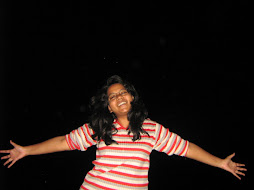

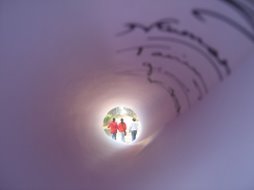
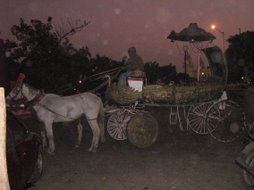
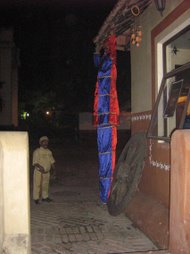
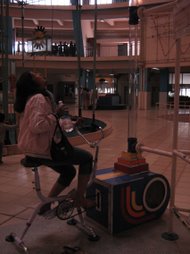
No comments:
Post a Comment